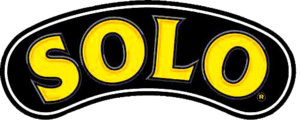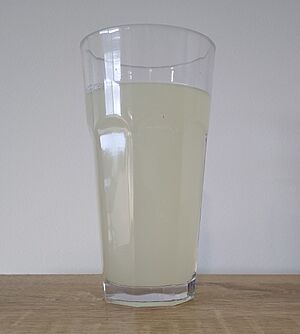Solo (Australian soft drink) facts for kids
 |
|
 |
|
| Type | Soft drink |
|---|---|
| Manufacturer | Asahi Breweries |
| Country of origin | Australia |
| Introduced | 1973 |
| Colour | White |
| Flavour | Lemon |
| Variants | Solo Original Solo Sub Solo Strong Solo Lemon & Lime Solo Low Carb Solo Guarana Solo Brew Solo Zero Sugar Solo Lemon Mango Zero Sugar Hard Rated Solo Lemon Pineapple Zero Sugar |
| Nutritional value per 1 can (375 mL) | |
|---|---|
| Energy | 750 kJ (180 kcal) |
|
43.1 g
|
|
| Sugars | 43.1 g |
|
0 g
|
|
|
Protein
|
0.2 g
|
| Minerals | Quantity
%DV†
|
| Sodium |
5%
68 mg |
| †Percentages estimated using US recommendations for adults. | |
Solo is a popular Australian soft drink with a refreshing lemon flavor. It's a fizzy drink, also known as a carbonated beverage. Asahi Breweries currently makes Solo under a special agreement.
Solo first came out in 1968. Its unique lemon taste was inspired by a traditional non-alcoholic drink called 'pub squash'. This drink was very popular in Australian pubs. Solo is well-known in Australia because of its long-running "Solo Man" advertising campaigns. These ads have featured many Australian actors over the years.
A regular 375mL can of Solo contains 43.1 grams of sugar. There are also different versions of Solo available. For example, Solo Zero uses artificial sweeteners instead of sugar. There has also been a lemon and lime flavor.
Contents
Solo's Journey: A Look at Its History
Solo was first launched by a company called Tarax in 1968. Later, in 1973, Cadbury-Schweppes took over the brand. In April 2009, Asahi Holdings (Australia) Pty Ltd bought Cadbury-Schweppes Australia. This meant Solo became part of Asahi. Asahi Group Holdings Limited is a large Japanese company that makes both drinks and beer.
The lemon flavor of Solo comes from a traditional Australian drink. This drink, called 'pub squash' or 'lemon squash', is made from sweetened lemon juice mixed with water. Solo is basically a fizzy version of this classic lemon squash.
Over the years, Solo has introduced different flavors. These include a lemon-lime flavor and a zero-sugar option. The zero-sugar version uses artificial sweeteners instead of regular sugar.
In 2018, Asahi Beverages, which owns Solo, made a promise to reduce sugar. This was in response to worries about high sugar content in drinks. Solo aims to lower its sugar content by 20% by the year 2025.
Solo Man: The Famous Advertising Campaign
The Solo Man Story
The "Solo Man" is a very famous advertising campaign for Solo. It started in the 1970s, soon after the drink was released. The most recent Solo Man ad came out in 2018. For almost 50 years, the Solo Man ads have shown an Australian man doing exciting and challenging activities. He does these things to "earn" his Solo drink. The Solo Man was often shown as a very strong and traditional masculine character. However, the 2018 campaign, called "thirst worthy effort," changed this. It showed the Solo Man doing more everyday activities at home.
Some of the adventurous activities the Solo Man has done in ads include:
- Kayaking down fast rivers
- Riding a wagon pulled by horses
- Driving a yellow speed boat
- Wrestling a wild horse (brumby)
- Fishing for a shark
- Windsurfing
- Doing a triathlon
- Wrestling a saltwater crocodile
- Chasing a barrel of lemons
Old slogans for Solo included "The thirst crusher" and "Light on the fizz, so you can slam it down fast." In the 1970s and 1980s, TV ads often said: "You've never tasted a lemon drink like Solo before. Unless it's one of those great lemon squashes that pubs used to make. Extra lemon tang, and not too many bubbles. Solo lemon: a man's drink."
In 2012, the Solo Man was brought back for new ads. Australian actor Adam Demos played the Solo Man. In these ads, he was shown in early Australia, swinging an axe. He puts lemons into a barrel, which then rolls away. He chases the barrel down hills and then drinks the whole barrel of lemon juice himself. A new slogan was also created: "Go hard, go solo." This campaign also featured the Solo Man doing an obstacle course to earn his drink. Limited edition Solo cans were released with single letters or a hashtag (#, G, O, H, A, R, D) for a social media promotion.
By 2018, the Solo Man's character changed. He was shown as a dad who makes costumes for a play, has a dog, and puts together furniture. This new approach came with the slogan "A Thirst Worthy Effort."
Who Played the Solo Man?
The very first "Solo Man" character was played by Michael Ace. He was a former PE teacher who also worked as a model. He starred as Solo Man in the 1970s and 1980s.
Another Solo Man was Terry Creasey, who is the father of Australian actor Joel Creasey. Terry Creasey was also a model and appeared as Solo Man in the 1980s. He was the Solo Man who ran up a hill with a dog and then drank a can of Solo at the top.
In the mid-1980s, Mark Robert Coutelas also played Solo Man. He was in the ad where Solo Man kayaks off a cliff and goes white-water rafting.
In 2012, Adam Demos, an actor from Wollongong, Australia, became the Solo Man. His Solo Man chased a barrel of lemons down a hill and then drank the juice on top of a cliff. Adam Demos has also appeared in TV shows like "... and the City" and "Rescue: Special Ops", and the movie "Falling inn love".
Solo's Sports Connections
In 2009, Schweppes Australia started a three-year partnership with Football Australia. During this time, the 'Goal of the Year' award was called 'SOLO Goal of the year'. This campaign featured Australian football player Harry Kewell. It aimed to bring back a street game called 'crushed can football', where people kick a crushed Solo can around.
Before the Football World Cup in South Africa in 2010, Solo launched an online campaign called 'lucky undies'. This was to support the Australian Socceroos team. They made 225,000 pairs of yellow underwear to be sold online or with the drink. This campaign also included a 1-minute TV ad, with the rest of the promotion done on social media. On May 24, 2010, spectators at a Socceroos match in Melbourne were given these bright yellow underwear to wear over their clothes.
How Solo's Ads Target Audiences
Solo has often used marketing techniques that focus on traditional ideas of masculinity. Their ads and brand image often target a male audience. This strategy shows men as brave, adventurous, strong, and able to think clearly.
Historically, Solo's advertising has focused on traditional ideas of masculinity. The Solo Man's strong character is shown by him doing extreme sports to "earn" his drink. These ads often show men being alert, standing tall, gripping things tightly, and being physically active. Solo has continued this masculine advertising through different extreme sports adventures.
Solo's marketing mainly targets men in Australia. This is partly because, between 2017 and 2018, men in Australia were twice as likely to drink a soft drink every day compared to women.
However, since 2018, Solo's "thirst worthy effort" campaign has started to change this. It rethinks what it means to be a Solo Man. Breaking from old traditions, the ads now show the Solo Man doing more everyday activities. These include building furniture and making costumes for a school play. This change reflects how society's ideas about gender roles are changing.
Who Does Solo Compete With?
In Australia, Solo competes with many other soft drinks that offer different flavors and prices. In 2020, Asahi Holdings, which owns Solo, had 15.4% of the Australian soft drink market. Coca-Cola Amatil Limited owned the largest share, with 39.8% of the market. Solo mainly competes with brands owned by Coca-Cola Amatil Limited, such as Coca-Cola, Fanta, Sprite, and Kirks. Smaller brands also compete with Solo. These include soft drinks from Tru Blu Beverages (like Pub Squash, Pips, and Vida) and Bundaberg Brewed Drinks Pty Ltd.
Hard Rated: A Different Kind of Solo
An alcoholic version of the drink, called Hard Rated, was launched in July 2023. It contains 4.5% alcohol. It was first called "Hard Solo." However, in November, the Alcohol Beverages Advertising Code decided that Carlton & United Breweries (CUB) had broken advertising rules. This was because they received complaints that the drink's branding appealed to younger people. Asahi Breweries, who own CUB Premium Beverages, argued that the Hard Solo cans looked different enough from the regular Solo. They pointed out that the Hard version had mostly black packaging and clear alcohol warnings. Despite this, CUB announced in November that it would change the drink's name to "Hard Rated."
Solo Around the World
Cadbury Schweppes sold a similar citrus drink called Rondo in the United States during the late 1970s and 1980s.
Inspired by the Australian Solo, Cadbury-Schweppes also sold an energy drink in the U.S. called Coolah Energy. Like Solo, it had a lemon flavor. It also contained caffeine. Its slogan was "Energy from Down Under." Coolah Energy has since been stopped.
What's in Solo?
Solo's Ingredients
Here are the main ingredients listed for Solo:
- Carbonated water (fizzy water)
- Sugar
- Reconstituted lemon juice (5%) (lemon juice made from concentrate)
- Food acids (330, 331) (these help with flavor and preservation)
- Natural flavor
- Preservative (211) (helps keep the drink fresh)
- Natural color (safflower extract)
Additives in Solo
The numbers you see for food acids and preservatives are called E-numbers. They are:
- E330 - Citric acid (a common acid found in citrus fruits)
- E331 - Sodium citrates (helps control acidity)
- E211 - Sodium benzoate (a preservative)
A typical 375 mL can of Solo has 43.1 grams of sugar. It contains 0 grams of fat, 0.2 grams of protein, and 68 milligrams of sodium. This provides 750 kJ of energy.
See also

